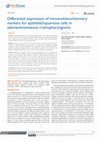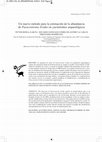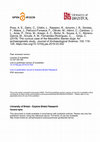Papers by Carlos Fernández-Rodríguez
dialnet.unirioja.es
Acceso de usuarios registrados. Acceso de usuarios registrados Usuario Contraseña. ...
Férvedes: Revista de …, 2008
Información del artículo Los restos faunísticos del Castro Grande de O Neixón (Boiro, A Coruña): ... more Información del artículo Los restos faunísticos del Castro Grande de O Neixón (Boiro, A Coruña): análisis zooarqueológico.

Journal of Archaeological Science. Reports, 2022
Domesticated dogs have been present in the Iberian Peninsula long before other domesticated speci... more Domesticated dogs have been present in the Iberian Peninsula long before other domesticated species, back to the late Palaeolithic period. Their origin is still uncertain, but dogs were already well established during the Chalcolithic period (ca. 5000–4000 BP). This study employed a multidisciplinary approach comprising osteometric, radiographic and palaeogenomic analyses to characterize Chalcolithic Iberian Canis remains. Two Chalcolithic archaeological sites – Leceia, Oeiras, in Portugal, and El Caset´on de la Era, Villalba de los Alcores, Valladolid, in Spain – were the main focus of this study. Osteometric and odontometric data from eleven other sites in Iberia were also included. Osteometric results show signs of phenotypic variability, likely the result of human-driven selective pressure. Dental radiographic and dental wear analyses allowed age at death estimation for four individuals (two juvenile and two adults). Three Chalcolithic Iberian dogs had their mitogenomes resequenced and the mitochondrial DNA analysis allowed to assign each individual to two of the major known haplogroups – A and C. Molecular sex infered by the chromosomeX/chromosome1 coverage ratio allowed to identify one female and two males. This study unveils some aspects of the Iberian Chalcolithic dogs: these dogs already exhibited various morphotypes whose profiles might be associated to the performance of certain tasks, as well as mitogenomes of two distinct lineages that help tracking the evolutionary paths of Iberian dogs.
The presence of shellfish remains in archaeological sites has prompted the development of a metho... more The presence of shellfish remains in archaeological sites has prompted the development of a methodology for their study. With this purpose, archaeomalacology emerges as a discipline within archaeozoology. A number of important aspects of life in ancient societies may be known by studying shellfish middens using analytical methods. The origin of food supplies, gathering strategies, economy, temperature of the sea water, trade, use of ornaments and so on, are all subjects approached by a discipline such as archaeomalacology.

Journal of Archaeological Science: Reports, 2022
Domesticated dogs have been present in the Iberian Peninsula long before other domesticated speci... more Domesticated dogs have been present in the Iberian Peninsula long before other domesticated species, back to the late Palaeolithic period. Their origin is still uncertain, but dogs were already well established during the Chalcolithic period (ca. 5000–4000 BP). This study employed a multidisciplinary approach comprising osteometric, radiographic and palaeogenomic analyses to characterize Chalcolithic Iberian Canis remains. Two Chalcolithic archaeological sites – Leceia, Oeiras, in Portugal, and El Caset´on de la Era, Villalba de los Alcores, Valladolid, in Spain – were the main focus of this study. Osteometric and odontometric data from eleven other sites in Iberia were also included. Osteometric results show signs of phenotypic variability, likely the result of human-driven selective pressure. Dental radiographic and dental wear analyses allowed age at death estimation for four individuals (two juvenile and two adults). Three Chalcolithic Iberian dogs had their mitogenomes resequenced and the mitochondrial DNA analysis allowed to assign each individual to two of the major known haplogroups – A and C. Molecular sex infered by the chromosomeX/chromosome1 coverage ratio allowed to identify one female and two males. This study unveils some aspects of the Iberian Chalcolithic dogs: these dogs already exhibited various morphotypes whose profiles might be associated to the performance of certain tasks, as well as mitogenomes of two distinct lineages that help tracking the evolutionary paths of Iberian dogs.

espanolEl analisis de los restos oseos de macromamiferos recuperados en poblados castrenos del li... more espanolEl analisis de los restos oseos de macromamiferos recuperados en poblados castrenos del litoral lucense nos permite reconocer los sistemas de aprovechamiento del entorno y definir los modelos ganaderos desarrollados por estas comunidades. Se destaca la importante presencia de restos de ganado vacuno frente a la escasa aportacion cinegetica. La combinacion de estos datos con los aportados por otros analisis (principalmente malacologicos) permite plantear un hipotetico modelo subsistencial. EnglishAnalysis of the large-mammal faunal assemblage recovered from coastal hillforts in the northern part of Lugo province enables the definition of patterns of cattle husbandry within the context of the broader subsistence systems of these communities. The presence of domesticated Bos remains in contrast to the small proportion of hunted animals is particularly significant. By combining data from this analysis with those from other analyses (mainly malacological), a model of the subsisten...
espanolSe presenta en este trabajo una recopilacion de mas de 250 dataciones absolutas obtenidas ... more espanolSe presenta en este trabajo una recopilacion de mas de 250 dataciones absolutas obtenidas en muestras procedentes de depositos naturales y yacimientos arqueologicos de Galicia. El listado se realiza siguiendo un orden cronologico (de mas recientes a mas antiguas). EnglishIn this paper a compilation of more than 250 datings obtained with samples from deposits and archaeological sites of Galicia is presented. The list of datings is disposed in a chronological order (from younger to older data).
espanolEl Museo del Bierzo se plantea como un espacio para conocer la historia de la Comarca. Par... more espanolEl Museo del Bierzo se plantea como un espacio para conocer la historia de la Comarca. Para la consecucion de este objetivo, el apoyo del material arqueologico resulta fundamental. En este articulo se evaluan las colecciones que constituyen los fondos arqueologicos del Museo. EnglishThe Museo del Bierzo has been conceived as a learning space for the knowledge of the history of this region. Archaeological material support is essential for achieving this goal. In this paper, the cultural and scientific value of the Museum archaeological collections is analysed.

Archaeofauna, 2015
La aparicion de restos de Paracentrotus lividus en yacimientos arqueologicos supone una important... more La aparicion de restos de Paracentrotus lividus en yacimientos arqueologicos supone una importante fuente de informacion que no siempre es posible valorar debido a la dificultad de cuantificar los restos y su aporte al conjunto estudiado. Recientemente, diversos autores han disenado sistemas de calculo para el NMI basados en el aparato bucal del erizo o sistemas de identificacion interespecifica en base al aparato genital del mismo. En este articulo se presenta un sistema de calculo de NMI basado en la aplicacion de las Categorias de Fragmentacion sobre el aparato genital. Este metodo se ejemplifica a traves del estudio de los restos presentes en los yacimientos de Punta Atalaia y A Lanzada (Galicia, Espana). La combinacion de este sistema con los ya existentes, permite amplificar la identificacion y contabilizacion de Paracentrotus lividus en yacimientos arqueologicos. PALABRAS CLAVE: CUANTIFICACION, PLACAS GENITALES, NUMERO MINIMO DE INDIVIDUOS, PARACENTROTUS LIVIDUS, ERIZO DE MAR...
El proceso de Romanizacion de la Peninsula Iberica y los cambios que supuso en la organizacion so... more El proceso de Romanizacion de la Peninsula Iberica y los cambios que supuso en la organizacion sociopolitica y socio-economica de las comunidades establecidas en ella es uno de los principales temas de investigacion en Arqueologia e Historia Antigua. El estudio de esta problematica se ha venido enfocando principalmente tanto por medio de los estudios de territorio como del analisis de los diversos materiales recuperados en las excavaciones arqueologicas. Sin embargo, la incorporacion de la informacion aportada por el estudio de los restos de fauna solo ha empezado a realizarse, en ocasiones todavia de modo muy puntual, en estos ultimos anos.

Journal of Archaeological Science, 2019
We investigated the genetic composition of six Canis remains from western Iberia, directly radioc... more We investigated the genetic composition of six Canis remains from western Iberia, directly radiocarbon dated to 7,903-7,570 years (cal BP). They were identified as dogs via their archaeological and depositional context, osteometry, and a high percentage of aquatic diet shared with humans. For comparison, genetic data were obtained from an additional 37 Iberian dog remains from the Neolithic to Late Antiquity, as well as two Palaeolithic and a Chalcolithic Canis identified as wolves. Previous data indicated that dog mtDNA haplogroup A (HgA) is prevalent in extant European dogs (>50%), in the Near East and Asia, but rare or absent (<10%) in European Canis older than 3,000 years (cal BP). We found a high frequency (83%) of dog HgA in Mesolithic Iberian dog remains. This is the first report of a high frequency of dog HgA in pre-Neolithic Europe. We show that, contrary to the current view, Canis with HgA did not necessarily arrive in Europe from East-Asia. This phylogeographical difference in HgA frequency demonstrates that genetic differentiation was high prior to, or as a consequence of, domestication which may be linked with pre-Neolithic local processes for Iberian wolf domestication. Our results emphasize that knowledge of both ancient wolves' and early dogs' genetic profiles from the European periphery should improve our understanding of the evolution of the European dog.
Regional Studies in Marine Science, 2018
This article attempts to set out a research agenda on the origin and evolution of hake exploitati... more This article attempts to set out a research agenda on the origin and evolution of hake exploitation in the Northeast Atlantic through a combination of zooarchaeological data with history and fisheries biology. An overview of archaeological hake remains from the Iberian Peninsula is presented and discussed in terms of a series of long-established paradigms. These are later expanded through an overview of issues currently facing the hake fishery, in particular its southern stock. The work concludes by specifying some research problems these issues imply an how historical and biomolecular analyses of archaeological specimens may improve our understanding of hake fisheries in former times in an attempt to implement a hidcasting to forecast strategy that could synergize with current fisheries research on the species.
European Journal of Archaeology, 2017
With the conquest of the Iberian Peninsula by the Roman Empire, the different societies in the no... more With the conquest of the Iberian Peninsula by the Roman Empire, the different societies in the north, north-west, north-east, east, and centre were grouped into the same province, Hispania Tarraconensis. This article sets out to assess whether this new, Roman, territorial organization affected previous animal husbandry and hunting practices. The taxonomic and osteometric study of faunal remains from ninety-four sites dated between the fifth century bc and third century ad provides an overview of animal husbandry and hunting before and after the Roman conquest. It shows that important changes took place and that this province was differentially exploited in terms of animal husbandry.
Uploads
Papers by Carlos Fernández-Rodríguez
study of the malacological remains of this site. Most species are of marine origin, although some land and
freshwater snails have been documented. Our analysis assesses the importance of this resource in the diet of
the Roman population, providing information on eating habits of the social elites. There are also some shells
that have been used as ornaments or decoration items. Asturica Augusta was clearly incorporated into a trading
network that linked the city with the coast.
RESUMEN: Asturica Augusta es una de las principales ciudades del noroeste en época romana. En este trabajo
presentamos un estudio de los restos malacológicos recuperados en este yacimiento. La mayoría son de origen
marino, aunque también se han documentado algunos moluscos fluviales y terrestres. Nuestro análisis evalúa
la importancia de este recurso en la dieta de la población romana, proporcionando información de los hábitos
alimentarios de las elites sociales. También hay algunas conchas que parecen haberse utilizado como adornos
o elementos decorativos. Asturica Augusta estaba integrada en una red comercial que la unía con la costa.